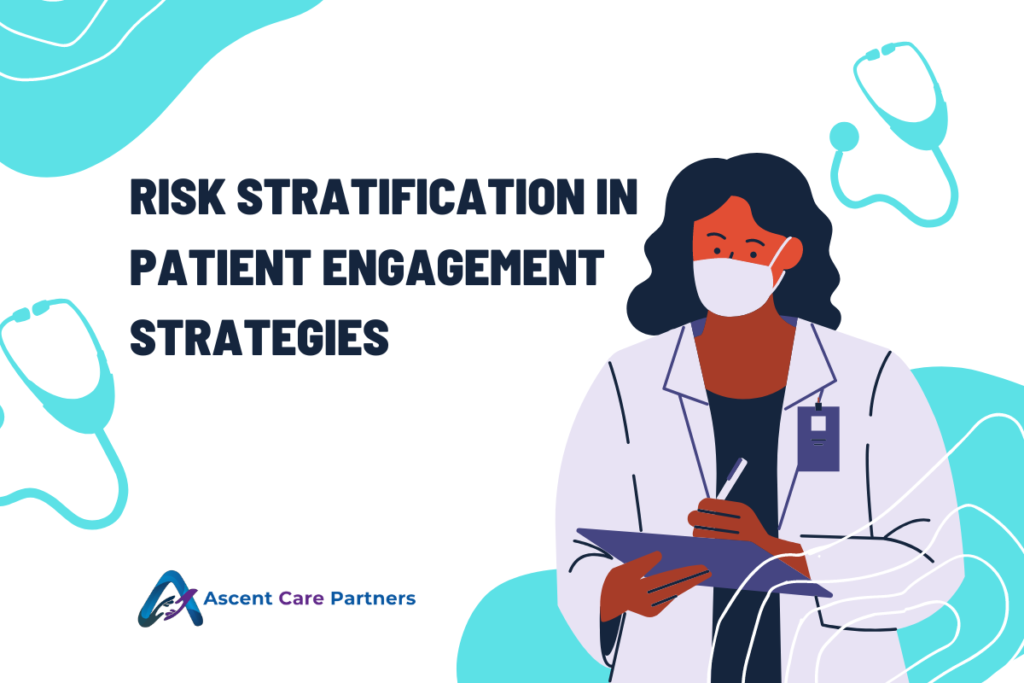Using risk stratification, providers can better target their patient engagement strategies to patients who need more meaningful health activation.
The American Academy of Family Physicians (AAFP) defines risk stratification as “the process of assigning a health risk status to a patient, and utilizing that risk status to direct and improve care.”
Stratification aims to prevent chronic disease, stabilize chronic conditions, and prevent patients from moving into higher-risk categories and incurring higher costs by preventing chronic disease, stabilizing chronic conditions, and preventing the acceleration of chronic diseases.”
WHAT is Risk-Stratification?
In risk stratification, patients are categorized into groups of similar complexity. For example, there will likely be close to 200 patients per 1,000 on a panel. Five percent (5%) of these “higher need” patients contributed to the total healthcare spending in the United States. Healthcare expenditures for people with five or more chronic diseases account for nearly half of all U.S. health expenditures. A person with chronic conditions has a 17-fold higher mortality rate than a person without chronic conditions.
To provide better healthcare, health centers need to segment their populations according to their healthcare needs. Groupings of risk can include: highly complex, high-risk, rising-risk, and low-risk individuals. Unique care models and intervention strategies are then used.
In other words, risk stratification allows healthcare providers to tailor patient engagement and care management efforts to the needs of individual populations. Patients without comorbidities might not need a lot of patient engagement at the moment, whereas patients with multiple complex chronic illnesses might need a high-touch engagement strategy.
In primary care, where margins are tight, intensive patient engagement may not be a viable investment. Conversely, low-touch patient engagement strategies can result in expensive acute episodes in the emergency department for complex patients.
Patients’ needs can help healthcare professionals determine which patient engagement strategies will have a positive impact on the industry. These patient engagement strategies should lead to healthier patients who cost the industry less money in the long run.
Highly complex: This is a small group of patients with the greatest care needs. This group, likely less than 5% of the population, has multiple complex illnesses, often including psychosocial concerns or barriers. Intensive care management of this population is essential. Through lower-cost care management services, this group hopes to improve health outcomes and prevent excessive emergency and acute care costs.
High-risk. The next tier of patients includes those with multiple risk factors, which, if left unchecked, could lead to them entering the highly complex group. This cohort comprises roughly 20% of the patient population and is engaged in a care management program offering personalized support for medical, social, and care coordination needs. A dedicated care manager works with patients to ensure appropriate chronic disease management and preventive services are received.
Rising-risk: This tier comprises individuals who generally have one or a few chronic illnesses or risk factors, and whose health varies from stable to precarious. Studies have demonstrated that offering further care management to this population led to a 12% reduction in the number of people who progressed to the high-risk group and incurred a 10% decrease in total costs. With patients at escalating risk, efficient models of care focus on controlling risk factors rather than the actual diseases. Common risk elements include obesity, smoking, blood pressure, and cholesterol levels. Identifying these threats allows staff to focus on the underlying causes of multiple ailments.
Low-risk: For patients in this group, the goal is to keep them healthy and engaged with the healthcare system without using unnecessary services. These patients have minor conditions that can be easily managed.
A STRATEGIC APPROACH TO RISK
The goal of risk stratification in patient engagement is to identify which patients are most likely to develop a costly condition, cost the organization money, or worsen pre-existing healthcare conditions. As a result, providers can better tailor their patient engagement strategies.
When a patient is healthy and young, her provider is unlikely to need to engage her extensively. The low-risk population will usually benefit from annual check-ups, preventive care, and providers who are readily accessible through the patient portal and other preferred communication channels in the case of health emergencies.
Diabetic patients, however, require more sophisticated patient engagement, including regular checkups, medication management, and care coordination.
According to a Commonwealth Fund report, risk stratification in patient engagement means targeting activation efforts accordingly.
PREVENTIVE CARE OUTREACH AND ACCESS ARE IMPROVED WITH RISK ANALYSIS
“The success of population health management depends, in part, on accurately identifying patients at high risk for poor health outcomes as well as preventable and costly health events,” the report authors said. Clinical markers are typically used in risk-stratification strategies.”
A healthcare organization usually uses artificial intelligence algorithms to stratify patients based on their EHR data. Algorithms may consider:
- Comorbidities or disease states
- The social determinants of health
- Utilization patterns of healthcare
- Visits to high-cost settings, such as the emergency room
Typically, healthcare experts refer to patients as being in one of four risk categories: highly complex, high risk, rising risk, and low risk. Providers can categorize patients into these categories using an algorithm that incorporates the above metrics (or other metrics relevant to their unique health system).
According to researchers in a 2019 Journal of Health Care for the Poor and Underserved article, such an approach enables a team to react quickly to varying degrees of illness and proactively manage risks. Using this approach, a multidisciplinary care team can target high-risk patients within the clinic as well as within their community.
Providers should be aware of patients who move into and out of different risk levels. A patient might have a heart attack one year, making him a high-risk patient. By the following year, that patient may have stopped smoking and started exercising, moving him into a low-risk or rising-risk category.
Keeping track of rising-risk patients, and designing upstream interventions for that risk category, is essential to reducing healthcare costs.
Real-time access to big data will be necessary to keep up with those fluctuations.
WHY Risk Stratification?
Risk stratification is a process of determining a patient’s risk level to direct care and improve overall health outcomes. This practice allows providers to identify the right care and services for distinct subgroups of patients. It also serves as the basis for creating personalized care plans at the individual level, while enabling population health management strategies at a larger community level. Common approaches to segmentation include classifying patients as high-, medium- (rising), or low-risk; this allows for tailored care models based on the needs of each subgroup.
A “one-size-fits-all” approach is ineffective from a clinical perspective and costly. To optimize efficiency, outcomes, and costs, health centers should look to their patient population and provide tailored care based on the identified risks and associated costs. For example, those in better health may not need a high level of intensive support and can be served through alternate models of care. Consequently, high-intensity resources should be reserved for higher-risk patients. Care models that are stratified according to risk with tailored services at each level can more clearly connect needs with resources that are more closely suited. Organizations that focus on population health management often use risk stratification when delivering care.
STRATIFYING PATIENTS BY IMPACTABILITY
Others are looking at impactability scores as a determinant of patient engagement instead of risk stratification scores.
An impactability score determines whether a patient is likely to respond positively to a patient engagement intervention. Patients with high health risks may not have a high impactability score. By using impactability scores, healthcare providers can prioritize their efforts and focus on those patients who are most likely to respond positively to interventions.
Additionally, emphasizing impactability can also prevent lower-risk patients from becoming high-risk patients by bringing them to the forefront.
According to the Center for Health Care Strategies (CHCS), organizations can use impactability analysis to determine where resources should be focused and where they are ill-equipped to serve certain patients. Organizations can use this concept to improve their understanding of which patients are more likely to respond to interventions designed to disrupt their path to becoming high-need, high-cost patients.
Researchers have found that it can be difficult to quantify how a patient will react to a certain preventive care intervention. However, some factors to consider include:
- Identifying patterns of high-yield care gaps; these are tangible steps that can improve the health and well-being of individuals
- Scores of patient activation
- Disenrollment patterns in programs
Organizations without text message outreach technology will not be able to reach patients who are receptive to text message outreach.
According to the Milbank Quarterly study, “predictive risk models can help identify patients at risk for future hospitalization. Impactability models help identify those patients likely to benefit from upstream care.”
Impactability and risk scores raise the question of who is excluded from the intervention. Some experts have argued that extremely high-risk patients may not benefit from upstream interventions because they are too complex and may have died before seeing outcomes, while others disagree.
According to the researchers, most interviewees believed very high-risk patients should receive upstream care since they are more likely to end up in a hospital.
It is the end goal of patient engagement to make sure that the right patient receives the right intervention at the right time. To determine who receives more extensive patient engagement efforts, it will be necessary to determine the degree to which a patient poses a clinical or financial risk to a healthcare organization.
Providers will be more efficient about where they spend their time as a result.
By engaging their high-risk patients, keeping them healthy, and reducing unnecessary or inappropriate healthcare utilization, providers will also reduce healthcare costs.



